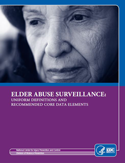Elder Abuse: Definitions
Featured Topic
Elder abuse is an intentional act, or failure to act, by a caregiver or another person in a relationship involving an expectation of trust that causes or creates a risk of harm to an older adult. (An older adult is defined as someone age 60 or older.) Forms of elder abuse are below.
- Physical Abuse: the intentional use of physical force that results in acute or chronic illness, bodily injury, physical pain, functional impairment, distress, or death. Physical abuse may include, but is not limited to, violent acts such as striking (with or without an object or weapon), hitting, beating, scratching, biting, choking, suffocation, pushing, shoving, shaking, slapping, kicking, stomping, pinching, and burning.
- Sexual Abuse or Abusive Sexual Contact: forced or unwanted sexual interaction (touching and non-touching acts) of any kind with an older adult. This may include but is not limited to forced or unwanted completed or attempted contact between the penis and the vulva or the penis and the anus involving penetration, however slight. It might also include forced or unwanted contact between the mouth and the penis, vulva, or anus; forced or unwanted penetration of the anal or genital opening of another person by a hand, finger, or other object; forced or unwanted intentional touching, either directly or through the clothing, of the genitalia, anus, groin, breast, inner thigh, or buttocks. These acts also qualify as sexual abuse if they are committed against an incapacitated person who is not competent to give informed approval.
- Emotional or Psychological Abuse: verbal or nonverbal behavior that results in the infliction of anguish, mental pain, fear, or distress. Examples of tactics that may exemplify emotional or psychological abuse of an older adult include behaviors intended to humiliate (e.g., calling names or insults), threaten (e.g., expressing an intent to initiate nursing home placement), isolate (e.g., seclusion from family or friends), or control (e.g., prohibiting or limiting access to transportation, telephone, money or other resources).
- Neglect: failure by a caregiver or other responsible person to protect an elder from harm, or the failure to meet needs for essential medical care, nutrition, hydration, hygiene, clothing, basic activities of daily living or shelter, which results in a serious risk of compromised health and safety. Examples include not providing adequate nutrition, hygiene, clothing, shelter, or access to necessary health care; or failure to prevent exposure to unsafe activities and environments.
- Financial Abuse or Exploitation: the illegal, unauthorized, or improper use of an older individual’s resources by a caregiver or other person in a trusting relationship, for the benefit of someone other than the older individual. This includes, but is not limited to, depriving an older person of rightful access to, information about, or use of, personal benefits, resources, belongings, or assets. Examples include forgery, misuse or theft of money or possessions; use of coercion or deception to surrender finances or property; or improper use of guardianship or power of attorney.
Why Is a Consistent Definition Important?
A consistent definition is needed to monitor the incidence of elder abuse and examine trends over time. Consistency helps to determine the magnitude of elder abuse and enables comparisons of the problem across locations. This ultimately informs prevention and intervention efforts.
Unfortunately, elder abuse has been 1) poorly or imprecisely defined, 2) defined specifically to reflect the unique statutes or conditions present in specific locations (e.g., states, counties, or cities), or 3) defined specifically for research purposes. As a result, a set of universally accepted definitions does not exist.
Additional References
Choi NG and Mayer J. Elder abuse, neglect, and exploitation: risk factors and prevention strategies. J Gerontol Soc Work. 2000;33:5–25.
Hall, JE, Karch, DL, Crosby, AE. Elder Abuse Surveillance: Uniform Definitions and Recommended Core Data Elements For Use In Elder Abuse Surveillance, Version 1.0. Atlanta (GA): National Center for Injury Prevention and Control, Centers for Disease Control and Prevention, 2016.
Ingram EM. Expert panel recommendations on elder mistreatment using a public health framework. J Elder Abuse Negl. 2003;15(2):45–65.
National Research Council. Elder mistreatment: abuse, neglect, and exploitation in an aging America. In: Bonnie RJ and Wallace RB, editors. Panel to review risk and prevalence of elder abuse and neglect. Washington DC: The National Academies Press;2003.
Tatara T. Elder abuse in the United States: an issue paper. Washington, D.C.1990.
Teaster P, Dugar T, Mendiondo M, Abner E, Cecil K, Otto J. The survey of state adult protective services: abuse of adults 60 years of age and older. Washington, DC. 2006.
Thomas C. The first national study of elder abuse and neglect: contrast with results from other studies. J Elder Abuse Negl. 2000; 12(1):1-14
- Page last reviewed: June 8, 2017
- Page last updated: June 8, 2017
- Content source:


 ShareCompartir
ShareCompartir

